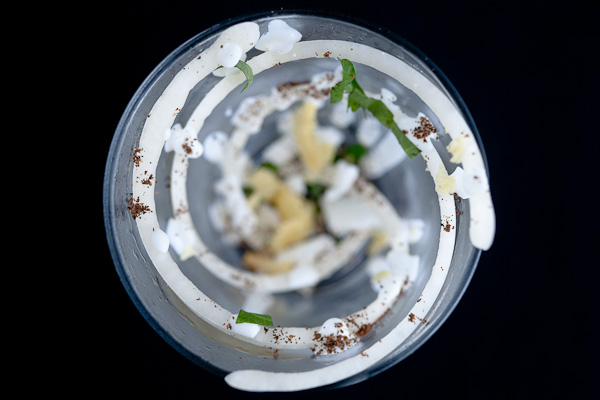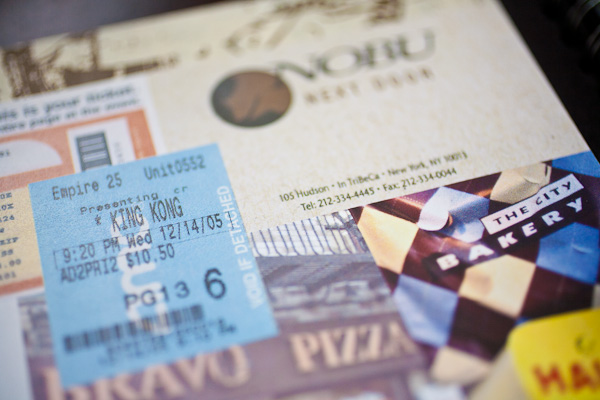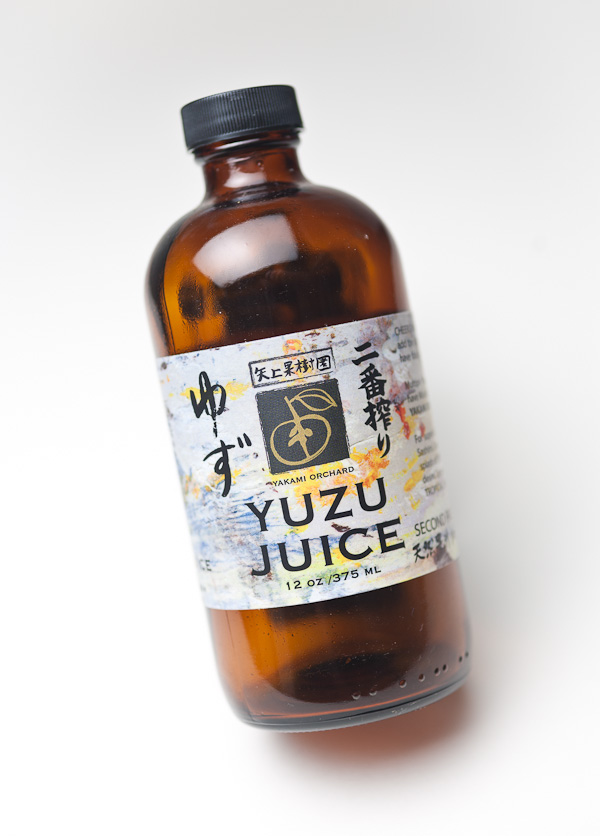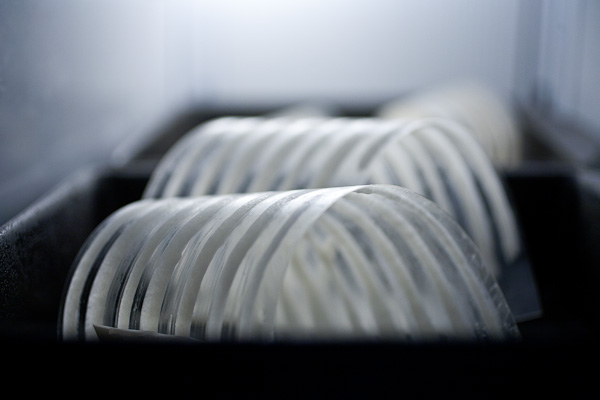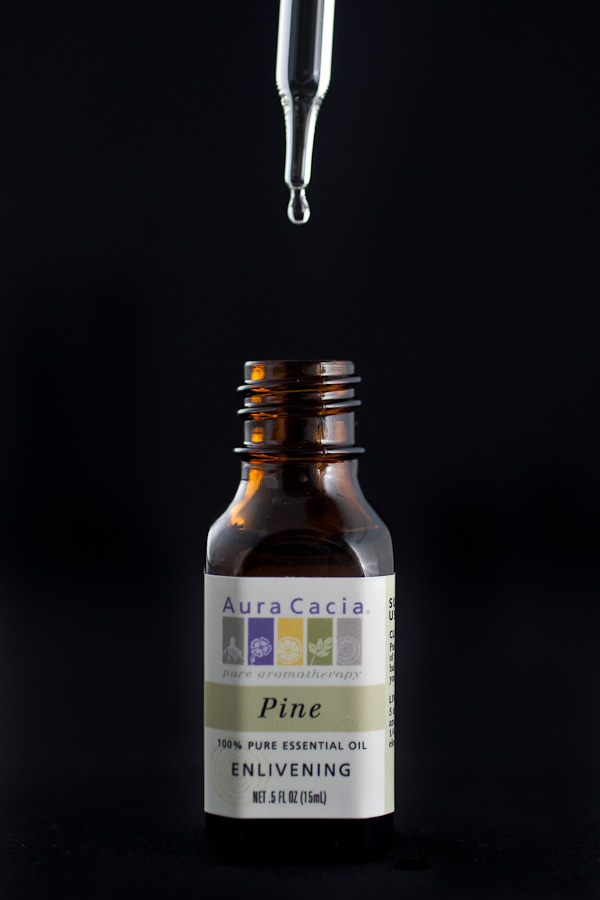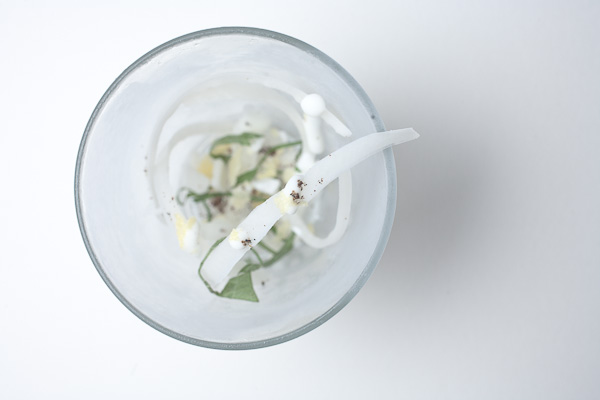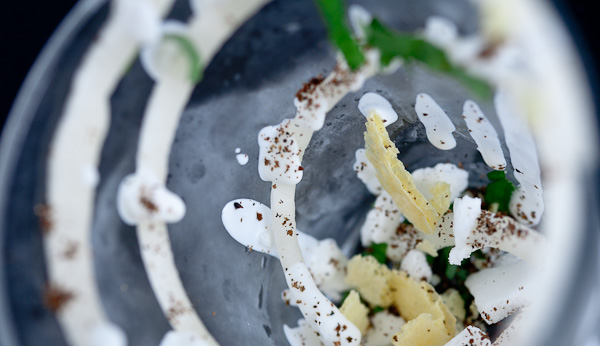When Sarah and I first met in person in New York City, after 8 months of emailing long-distance, it was a pretty momentous occasion. I wanted to take her on a REALLY good date, so I suggested dinner and a movie. The movie was King Kong, which I’d worked on for the year or so leading up to my trip to Manhattan, and which was opening in theaters the night after we met. I solicited opinions about dinner from my coworkers at Weta, who know good food the world over. Narrowing it down to a list of 4-5 choices, I pitched the choices to Sarah, and she settled on Nobu.
I wanted to dig up some photos of that trip, but donkey balls that we were, neither Sarah nor I thought to take our cameras with us at any point that week. When we realized this a few days later, Sarah decided to just draw us a photo album.
A few weeks after I returned to New Zealand, I came across a Nobu cookbook in Moore Wilson’s. I snagged it, both because of the sentimental value and because I was genuinely interested in trying to make some of the beautiful dishes that were in it. I started working through it (not quite with the focus or obsession I’ve got going on here), and found one of my favorite recipes involved tuna topped with ginger and a “yuzu vinaigrette’. I hadn’t heard of yuzu before, but some googling around told me that it was a citrus that tasted similar to lemon/lime, so I just substituted that each time I made it. I never did see Yuzu in any grocery shop in New Zealand.
One of my first trips to Berkeley Bowl, I was wandering through the Asian Foods aisle, and lo and behold, I saw a tiny bottle of yuzu sitting near other bottles of amino acids and soy sauce. I snagged it, mostly wanting to know what it tasted like after wondering for so long. It wasn’t until I got home and was flipping through the Alinea cookbook that I found this recipe, and got excited that I would be able to make it properly.
Yuzu is a citrus fruit and plant originating in East Asia. The fruit of the yuzu shrub is roughly the size of a mandarin or orange, and the fruits range from green to orange in color, depending on ripeness. The flavor of yuzu is actually more grapefruity than lemon/lime; it’s very tart, and has some orange/mandarin overtones. Asian friends at work described it as ‘spicier’ than other citrus, an adjective I found interesting.
The idea with this dish is to make several long, twisting threads of Yuzu ice, which is itself achieved by making a pudding by blending Yuzu gelled with Agar. The recipe directs me to spread the yuzu pudding on sheets of acetate, run a pastry comb along the sheet to create ‘rows’ of yuzu, and then form the sheet into a spiral before freezing it. This process is fairly straightforward, aside from one note in the book insisting that I use “1/8″-thick acetate”, which I’m pretty sure is a misprint. Forming the spirals requires a bit of dexterity but isn’t too difficult if you keep your work area tidy (if you get yuzu pudding all over everything, the acetate is difficult to hold on to).
While these were freezing, I worked on the rest of the components for the dish. The yuzu spirals are meant to be topped with powdered black sesame seeds, shiso leaves, yuzu powder, and pine yogurt. The pine yogurt is easy enough to make, using Greek yogurt and some pine oil, which I again found up at Berkeley Bowl in their medicinal/aromathy area.
The Yuzu powder was made in a very similar way as the Lime Sugar was made in the Kuroge Wagyu dish; eggs serve as a sort of emulsifier/vehicle for the yuzu, and are whipped to a froth before being dehydrated into something that resembles a cracker. It’s then loosely crumbled into small, rocklike shapes.
The biggest challenge for me was removing the frozen yuzu spirals from the acetate; they were extremely delicate, and cracked and broke very easily. I tried several different things to help them release more easily, including use of cooking spray on the acetate, but it didn’t seem to help. The strips also melted in seconds. This was an early plating I tried; it’s tough to make out but the strips are maybe a third of their designed length:
The intact pieces looked nice and delicate, but I just couldn’t seem to get one off its strip wholly. The recipe for the yuzu pudding makes enough of it for me to try several times though. Eventually I tried putting the pudding in a squirt bottle and squirting it onto the acetate. This ended up working perfectly. The yuzu threads were no longer quite as perfect in size (it’s tough to keep an even pressure on the squirt bottle while drawing a line with it), but they came off the acetate perfectly. I understand the reason for the pastry comb; in a restaurant, needing to do this for dozens of patrons, you need a mechanism for consistency. I wonder if my pastry comb just left rows that were too thin or something.
I expected as I was making this for the whole thing to be dessertlike. It wasn’t at all; it’s presented on a menu between a heavy pork dish and a fois gras dish, so it’s meant to be a palette cleanser. To that end, it works beautifully. The yuzu’s acid is cleansing, and the lack of too much sugar makes it feel light in the mouth, like a sip of lemonade. The sesame adds a warm nuttiness that’s really nice, and the pine yogurt and shiso are both really unique flavors that work harmoniously with the yuzu. Sarah felt it was her favorite thing I’ve made so far. Even with the iffy plating, it was delicious.

